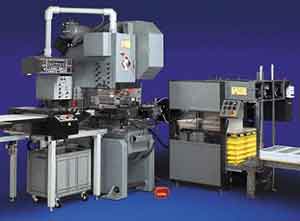New Post-print Perspective - Fine Die-cutting Process (3)
Many of the die-cut products mentioned above require a very precise die-cutting system (Figure 4). These devices include a sophisticated optical positioning system that adjusts sleeve registration in three directions (X, Y, and rotation angle) each time the stamping is performed. These three axes are precisely positioned with an error of no more than ±0.005 inches and an accuracy of up to two hairline widths, which is the smallest range that the human eye can discern. The types of die-cut products continue to grow, including electroluminescent cell phone panels, ballot papers, and casino poker cards, all requiring minimal die-cutting errors.
Adapt to the length of the job
Many long-run die cutting operations are suitable for rotary die cutters and platform stamping die cutters. The flexibility of these die cutters is lower than that of precision die-cutting. It can handle simple processing and does not require very precise die cutting. If the mass production cost is very low, even the high-cost platform imprinting die Cutting machine, with the increase of production, the cost will be reduced.
For short-run jobs, the cost of running rotary die cutters and flatbed imprinters is high. In addition, many of the latest die-cut products are made of flexible plastic materials, such as PVC, and the use of improper equipment in die-cutting can cause some problems in processing. Therefore, it is very important to know when to use high-precision, optical registration die cutting tools to help the rotary die cutter and the flat bench die cutter work well. Precision systems are easier to process complex products. They are suitable for light-cutting, creasing and embossing. Such systems include rotary die-cutting machines for web widths and platform die-cutting machines for narrower job widths.

Figure 4 precision die-cutting equipment
The high-accuracy intermittent die-cutting system handles a wider range of products, including those that require precision die-cutting. The standard component equipment enables the die cutting equipment to be produced together with the automatic delivery system and additional printing equipment to form an automatic assembly line.
Unlike rotary die-cutting machines and platform-type embossing machines, high-precision die-cutting systems are suitable for both sheet-fed and web-fed papers. It cuts 120 to 150 times per minute, and can process 50,000 small single-sheet products per hour for a 30-inch wide format system, and the production speed is matched to an online laminator or digital press.
The most delicate part of this die-cutting system design is that it can quickly adjust the steel die-cutting tools in a short period of time, allowing quick job replacement and reduced job preparation time. The steel mold used for short-cut die-cutting can be manufactured in just a few hundred dollars in a few hours. Therefore, those who operate wire mesh and digital printing and printing companies can supplement their die-cutting operations to quickly complete the production of short-run jobs.
Die-cutting systems must coordinate with other equipment to create maximum economic benefits. The labor force required for die-cutting processing is more, and it is used for loading paper. On the other hand, the die-cutting system and screen printing, inkjet printers, and post-press processing equipment form a production line that can produce new products.
(to be continued)
Single Side Breast Pump
Zhejiang Carebao Co., Ltd , https://www.carebao.com